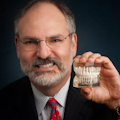Can the introverted dentist be successful?
Dentists are facing challenging times. None of us could have imagined what the past year would be like. And what will the future be like? No one knows. Even in the most difficult times, I have learned that there are basic principles to follow that apply to all styles of practice—whether you are an introvert or an extrovert. All of us in private practice are facing the pressures of large corporate practices and dental insurance issues. I’m frequently asked these questions: How do you have a fee-for-service practice in 2021? What can I do to build a practice like yours? What can I do to protect what I have worked so hard to build over the past years? This is what I’ll talk about in this article, along with one important technology that will help you in your practice.
When I graduated from Tufts University School of Dental Medicine in 1978, I wanted to work as a dental associate in a practice that would eventually lead to a partnership. This did not work out at all; in fact, I was fired from three dental jobs in one year. Whether it was me or them did not matter because my wife and I had a child on the way.
So, with my wife’s encouragement, I decided to start a new practice—our own practice—on a second-floor walk-up in Stratford, Connecticut. The reception area had no windows, the chairs were mismatched, the desk was a door balanced on two filing cabinets, and my wife manned the front desk for only one week because our first child was born a week later. Everything and everyone seemed to be against us. I knew failure wasn’t an option though. We had nowhere to go but up, and up we went! But how did it happen, and what was the main thing that made it work?
Everyone needs a little help
I began my practice in what I would call the Golden Age of Dentistry. There was not a lot of competition then, and, more importantly, dentists were nice to one another. Older dentists referred patients to me because they were too busy and knew I needed a start. In the early days of my practice, Drs. Earl Slusky, Ted Spivak, Herb Steinman, and Allan Patterson all extended their help to me as a young professional. They are no longer around, but a big thank-you goes out to them. Everyone needs a little help. When I help young dentists now, I remember that someone did it for me as well. There is enough for everyone in dentistry if you do the right things and take care of your patients.
Passing the baton: The young/old dentist dilemma
The most important part of the story comes now. My first patient in dental school was an older gentleman named Mr. Larry Maher. Like so many patients, he was a true dental phobic. Truthfully, as a new dental student, I was just as scared as he was. Mr. Maher was my first injection, my first amalgam, my first root canal, and my first extraction. What a lucky guy! After that first procedure, I called Mr. Maher (whom I always called Mr. Maher and treated for 35 years thereafter). I called not just to see how he was, but to make sure he was still alive!
I was trembling while I dialed that touch-tone phone. I remember saying, “Hi, Mr. Maher. This is Jeffrey Hoos calling. I was wondering how you are feeling.” He replied, “Oh, Jeffrey, it is so nice to hear from you, and I am great. Didn’t we both do well today? It was so nice of you to call to check on me. You are going to be a very successful dentist, and remember this: don’t ever change.” Don’t ever change. That was the best advice I have ever gotten, and it was great advice I would never forget.
The value of truly caring
Why are these calls so important, and why did this type of communication really work to help build my practice? The answer is quite simple. Dr. Omer Reed, a successful dentist and practice coach, used to say: “No one cares how much you know until they know how much you care.” The relationships you build with your patients will only help grow and maintain your practice while providing better dentistry for patients with whom you’ve built a strong relationship.
I know how lucky I am when it comes to relationships, both personally and professionally. I have always found it easy to talk to people. My mother put me in speaking contests as a child, so public speaking came naturally to me. When I was asked to speak at dental meetings, the hardest part was putting the slides together to make it interesting to the audience. The more I lectured, the more I found I really enjoyed it. I would talk about materials and methods, but I also always spoke about balancing the art, science, and business of dentistry (figure 1). What do I mean by that?
In my experience, I’ve found that the key to success in dentistry is to make sure everything is about finding the balance between the following—art (creating beautiful outcomes), science (an evidence- and research-based approach), and business (timely and consistent procedures).
One additional and greater factor involves the relationships you have with your patients. The big problem was that calling my patients was time-consuming. Although I am an older dentist, I have embraced new technology in my practice for years. There wasn’t anything I wouldn’t incorporate if I thought it would help my patients and help me provide the highest quality care. Technology would come and go, but it included Cedeta, hydrocolloid, electric handpieces, digital x-rays, and certainly cone beam technology.
Then, my dental detail person introduced me to something new. He said, “I have been to your lectures, and I know about your comfort care calls. But there is a different way. You need to try a system called APE.” I looked it up—APE: automated patient experience. Almost immediately, this technology made a huge difference in my life. It has freed up my time, and the patient experience feedback has been amazing. It is a technology that has made things easy for me when it comes to my comfort care calls. Our patients are so used to texting that it’s like making a comfort care call automatically. My staff doesn’t have to remember to send me those call lists, and I can reach my patients quickly and effectively. It has relieved a burden from the front desk in these times when staffing has become a challenge. I quickly welcome any technology that will help my front desk staff. The most important thing is the great feedback I get from my patients.
Most dentists are introverts, but all dentists want to have successful practices. It is important to have a strong mission statement. If you don’t have one, steal mine: Providing the highest quality care, for the most patients, while maintaining the balance. Remember, it is all about balancing the art, science, and business of dentistry. Building relationships with patients is critical, so why not let technology make it easier for you? Take advantage of this new innovation, and you’ll learn what works for you in terms of finding your balance.
Editor's note: This article appeared in the October 2021 print edition of Dental Economics
Jeffrey C. Hoos, DMD, a 1978 graduate of the Tufts University School of Dental Medicine, started his private practice as a one-operatory walk-up and grew it to a four-doctor practice with 25 staff members. He lectures on innovative techniques that balance the art, science, and business of dentistry. One of the first general dentists to be Brånemark certified for implant placement, his office has become a teaching center for restorative and implant dentistry. Contact him at [email protected].
About the Author
Jeffrey C. Hoos, DMD
Jeffrey C. Hoos, DMD, a 1978 graduate of the Tufts University School of Dental Medicine, started his private practice as a one-operatory walk-up and grew it to a four-doctor practice with 25 staff members. He lectures on innovative techniques that balance the art, science, and business of dentistry. He is one of the first general dentists to be Brånemark certified for implant placement, and his office has become a teaching center for restorative and implant dentistry. Contact him at [email protected].


